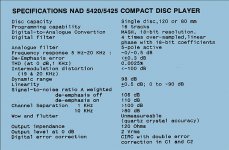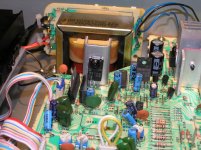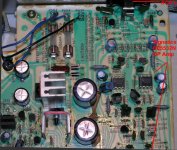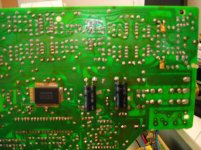I have my NAD 5425 cd player apart to replace the display lights again. While I have it open I would like to improve the sound a bit. I have deadened the chassis with Dynamat and the ICs with lead tape, all with great results. I think that the high freqs are the worst part of the sound, so I'm thinking of replacing the ouput coupling caps with something better. Does anyone know which ones they are? Should I remove the muting transisters? Should I remove the power supply decoupler resisters? A schematic would of course help. Thanks
Just wondering if you'd found the schematics. I could email it if you need it.
BTW, what's your thoughts about modifying the NAD5425? Have you done any to it yet?
Howard
BTW, what's your thoughts about modifying the NAD5425? Have you done any to it yet?
Howard
I just found a NAD 5425 CD player at the landfill site last week and grabbed it because it looked to be in good shape and is a heavy piece of gear, indicating that it is probably made out of real materials and has some quality to it unlike the BPC that one usually sees. I'll bet it has a real power supply with an iron, 60 Hz xfmer instead of a flaky ultrasonic switchmode miracle looking for any excuse to fuse.
I haven't had a chance to test it yet.
Is this a worthwhile player to fix/upgrade? Are the original DAC's up to audiophile expectations?
I haven't had a chance to test it yet.
Is this a worthwhile player to fix/upgrade? Are the original DAC's up to audiophile expectations?
it W O R K Z !!!!!!
I finally got a chance to look at the NAD player last night which I saved from the local landfill site. The power light and display are dark, no clues that the unit is powered up BUT..... it works! 😉
It appears to operate perfectly and sounds fine as far as I could tell on one CD which happened to be in the tray as found.
Man, there's nothing like having a good dump. 😀
Anatech or anyone else have any knowledge of what usually goes wrong with this consumer stuff when a display goes dead? Do these things get a dedicated supply rail for the LED's?
I finally got a chance to look at the NAD player last night which I saved from the local landfill site. The power light and display are dark, no clues that the unit is powered up BUT..... it works! 😉
It appears to operate perfectly and sounds fine as far as I could tell on one CD which happened to be in the tray as found.
Man, there's nothing like having a good dump. 😀
Anatech or anyone else have any knowledge of what usually goes wrong with this consumer stuff when a display goes dead? Do these things get a dedicated supply rail for the LED's?
Re: it W O R K Z !!!!!!
I had a dead display in my otherwise fully-functioning family room CD changer (a cheap Sony - don't remember the model). Turns out the flaky ribbon cable that connects the display panel to the main board had slid out of it's socket. Plugged it back in and glued it down in a couple of places so as not to get bumped by the disc loading mechanism anymore and it works like a champ. Hopefully, you'll be so lucky, too!
mlloyd1
I had a dead display in my otherwise fully-functioning family room CD changer (a cheap Sony - don't remember the model). Turns out the flaky ribbon cable that connects the display panel to the main board had slid out of it's socket. Plugged it back in and glued it down in a couple of places so as not to get bumped by the disc loading mechanism anymore and it works like a champ. Hopefully, you'll be so lucky, too!
mlloyd1
rcavictim said:I finally got a chance to look at the NAD player last night which I saved from the local landfill site. The power light and display are dark, no clues that the unit is powered up BUT..... it works! 😉
It appears to operate perfectly and sounds fine as far as I could tell on one CD which happened to be in the tray as found.
Man, there's nothing like having a good dump. 😀
Anatech or anyone else have any knowledge of what usually goes wrong with this consumer stuff when a display goes dead? Do these things get a dedicated supply rail for the LED's?
Re: Re: it W O R K Z !!!!!!
Thanx m. Guess I'll have to yank the cover.
mlloyd1 said:I had a dead display in my otherwise fully-functioning family room CD changer (a cheap Sony - don't remember the model). Turns out the flaky ribbon cable that connects the display panel to the main board had slid out of it's socket. Plugged it back in and glued it down in a couple of places so as not to get bumped by the disc loading mechanism anymore and it works like a champ. Hopefully, you'll be so lucky, too!
mlloyd1
Thanx m. Guess I'll have to yank the cover.
Cover yanked. Spotless inside. No signs of smoke. Actual fiberglass circuit board, not cheapo phenolic. As I predicted a 60Hz analog PS. copper and iron xfmer 18-0-18 VAC, two fuses to discrete 1N400? bridge followed by electrolytics and 3-term regulators. Good. I see some (4) Signetics NE5532 op amps (8 pin dips), two in each channel's audio path. No ribbons to the display, it is mounted 90 degrees to the main board with a light hood/dust cover.
Schematic time. The unit is circa 1992.
Schematic time. The unit is circa 1992.
john8417 said:I have my NAD 5425 cd player apart to replace the display lights again....
OK, just happened to read the post again that started this thread. Duh!
 Ya' mean this baby uses light bulbs inside that display cover? That must be my problem too since as I discovered all else appears to work perfectly.
Ya' mean this baby uses light bulbs inside that display cover? That must be my problem too since as I discovered all else appears to work perfectly.Hi Rob!,
Just saw the thread.
Let me have a look here ...... No manual - darn.
Also keep an eye out for solder joints on the regulators and a device called a semifuse. They look exacty like a transistor, but with only two legs. You will generally not be able to see the legs.
Find the oscillator and stick a scope probe on it. You should be able to see a scan waveform on the display pins.
If you get stuck, you are more than welcome to stop by Rob. Great find!
-Chris
Just saw the thread.
Let me have a look here ...... No manual - darn.
Also keep an eye out for solder joints on the regulators and a device called a semifuse. They look exacty like a transistor, but with only two legs. You will generally not be able to see the legs.
Find the oscillator and stick a scope probe on it. You should be able to see a scan waveform on the display pins.
If you get stuck, you are more than welcome to stop by Rob. Great find!
-Chris
anatech said:Hi Rob!,
Just saw the thread.
Let me have a look here ...... No manual - darn.
Also keep an eye out for solder joints on the regulators and a device called a semifuse. They look exacty like a transistor, but with only two legs. You will generally not be able to see the legs.
Find the oscillator and stick a scope probe on it. You should be able to see a scan waveform on the display pins.
If you get stuck, you are more than welcome to stop by Rob. Great find!
-Chris
Thanx Chris,
I'm going to try to remove the display rear cover to find the alleged grain of wheat bulbs. I wonder if I could replace 'em with white LED's and series limiting R's?
If it is a scanned self illuminating display i'll try your advice.
Hi Rob,
Even LCD displays are scanned. The waveform has an average zero, that's all.
You may be able to use those night lights. I've been thinking of ways to use them as you can get 3 for $4 ~ $5. Nifty green colour on some of them. Pressure contact fit for 120 VAC.
You can use white LED's but the emission angle can't compare to a light bulb. You may have to space them back. If it's edge lighting - you're in business. Run them with a current source. Cheap and cheerful.
-Chris
Even LCD displays are scanned. The waveform has an average zero, that's all.
You may be able to use those night lights. I've been thinking of ways to use them as you can get 3 for $4 ~ $5. Nifty green colour on some of them. Pressure contact fit for 120 VAC.
You can use white LED's but the emission angle can't compare to a light bulb. You may have to space them back. If it's edge lighting - you're in business. Run them with a current source. Cheap and cheerful.
-Chris
NAD CD player tweaks.
Hi Everybody.
I hope this is the right place for this post!
I have had a lot of success modifying my NAD c542 player. The upgrades are as follows:
1. Installed an earth wire (earthed to case screw).
2. Fitted damping material to the case.
3. Mounted the transformer on cushioned 'feet'.
4. Removed the muting transistors-Q301-304.
5. Bypassed the output resistors-R375 and R379 as well as R380 and R376.
6. Disabled the display by cutting jumpers J518 and J519.
7. Removed the stock feet and fitting solid 'cones'. These are the cast iron components used on the top of fence poles.
Of the changes, disabeling the display made the greatest improvement!!! It was like I was listening to a new player. If I had spent $1000 on a new player and I got this improvement I would have been very pleased.
My question is what to do next. I would like to keep the player and get it delivering its full potential without going nuts. I have some 2.2uF 400v Auricaps and would like to replace the coupling caps between the dac and the opamp (currently 100uF Muse polarized bypassed with 0.22uF). Would this make a significant difference? I like the character of the sound as it is but would like to get more of the same! I will replace the resistor following the capacitor with one of a higher value (50-60k).
While I am at it would upgrading all of the resistors in the signal path be beneficial? One last question...How do I disconnect the thin ribbon cable connecting the lazer pickup and circuit board?
Thanks in advance for your valued feedback!
Hi Everybody.
I hope this is the right place for this post!
I have had a lot of success modifying my NAD c542 player. The upgrades are as follows:
1. Installed an earth wire (earthed to case screw).
2. Fitted damping material to the case.
3. Mounted the transformer on cushioned 'feet'.
4. Removed the muting transistors-Q301-304.
5. Bypassed the output resistors-R375 and R379 as well as R380 and R376.
6. Disabled the display by cutting jumpers J518 and J519.
7. Removed the stock feet and fitting solid 'cones'. These are the cast iron components used on the top of fence poles.
Of the changes, disabeling the display made the greatest improvement!!! It was like I was listening to a new player. If I had spent $1000 on a new player and I got this improvement I would have been very pleased.
My question is what to do next. I would like to keep the player and get it delivering its full potential without going nuts. I have some 2.2uF 400v Auricaps and would like to replace the coupling caps between the dac and the opamp (currently 100uF Muse polarized bypassed with 0.22uF). Would this make a significant difference? I like the character of the sound as it is but would like to get more of the same! I will replace the resistor following the capacitor with one of a higher value (50-60k).
While I am at it would upgrading all of the resistors in the signal path be beneficial? One last question...How do I disconnect the thin ribbon cable connecting the lazer pickup and circuit board?
Thanks in advance for your valued feedback!
Ribbon cables (do you mean flexi print) are just a push fit normally. Sometimes the socket has a "locking bar" that has to flipped forward first but these are the exception.
I doubt whether replacing the resistors would be of any audible benefit... more a case of if you think it will improve things then it probably will 🙂
Does this player use opamps ? If so there could be some great benefits in looking at alternatives (depending what is fitted originally of course).
I doubt whether replacing the resistors would be of any audible benefit... more a case of if you think it will improve things then it probably will 🙂
Does this player use opamps ? If so there could be some great benefits in looking at alternatives (depending what is fitted originally of course).
Hi Everybody.
I hope this is the right place for this post!
I have had a lot of success modifying my NAD c542 player. The upgrades are as follows:
1. Installed an earth wire (earthed to case screw).
2. Fitted damping material to the case.
3. Mounted the transformer on cushioned 'feet'.
4. Removed the muting transistors-Q301-304.
5. Bypassed the output resistors-R375 and R379 as well as R380 and R376.
6. Disabled the display by cutting jumpers J518 and J519.
7. Removed the stock feet and fitting solid 'cones'. These are the cast iron components used on the top of fence poles.
Of the changes, disabeling the display made the greatest improvement!!! It was like I was listening to a new player. If I had spent $1000 on a new player and I got this improvement I would have been very pleased.
My question is what to do next. I would like to keep the player and get it delivering its full potential without going nuts. I have some 2.2uF 400v Auricaps and would like to replace the coupling caps between the dac and the opamp (currently 100uF Muse polarized bypassed with 0.22uF). Would this make a significant difference? I like the character of the sound as it is but would like to get more of the same! I will replace the resistor following the capacitor with one of a higher value (50-60k).
While I am at it would upgrading all of the resistors in the signal path be beneficial? One last question...How do I disconnect the thin ribbon cable connecting the lazer pickup and circuit board?
Thanks in advance for your valued feedback!
You probably should have started a new thread as this one is quite old and is about the 5425 not the C542.
1. Regarding the earth wire, where exactly is it installed and why do you think you need it?
4. Removing the muting transistors will let non-music noises through the outputs. I am not sure what happens if you play a badly scratched CD with uncorrectable errors. Could get a loud screech through the outputs (or not).
5. Shorting the output resistors is a bad idea. The OPA2134 is not especially tolerant of capacitive load and keeping at least one resistor is advised to maintain op amp stability.
6. Disabling the display is an interesting modification. I may try this on my unit but will add a switch on the back to turn the display on or off as needed.
I'm not sure why NAD put a 10K load on the DAC but raising it to 50K and using 2.2uF to couple the signal seems ok.
I don't recall any connector latches on the laser cable last time I had mine apart. The connectors may just be tight.
Thanks for all of the responses!
The Cd player is a C542, not a 5425! Sorry, my mistake, I'm new here so don't be too hard on me🙂
Re the questions. I connected an earth wire to the chassis screw (nearest the cable inlet). I was getting a hum from my speakers.
I don't seem to have a problem with a capacitive load on the opamp. I use solid copper wire in PTFE and run the wire separate (lower capacitance learned from my internet searching-may be wrong) and have no input cap on the amp. I have no problem with any DC offset.
I removed the muting transistors a few years ago and the only time I hear strange things is when I turn the player off while the amp is still on.
I installed the 2.2uF Auricaps last night along with Takman 22k resistors (a little on the low side but i had them in stock). Sound is wonderfully smooth and neutral. No simbleance (spelling?). It is missing some of the warmth it had previously. I will wait a few days.
The rest of the system is gainclone (Peter Daniel premium type), discrete series shunt attenuator (Caddock/Alps) and Fostex FE126e's in frugelhorn enclosures. Stepped attenuator coming later this week!
Will keep you posted on caps.
Best wishes to all!
The Cd player is a C542, not a 5425! Sorry, my mistake, I'm new here so don't be too hard on me🙂
Re the questions. I connected an earth wire to the chassis screw (nearest the cable inlet). I was getting a hum from my speakers.
I don't seem to have a problem with a capacitive load on the opamp. I use solid copper wire in PTFE and run the wire separate (lower capacitance learned from my internet searching-may be wrong) and have no input cap on the amp. I have no problem with any DC offset.
I removed the muting transistors a few years ago and the only time I hear strange things is when I turn the player off while the amp is still on.
I installed the 2.2uF Auricaps last night along with Takman 22k resistors (a little on the low side but i had them in stock). Sound is wonderfully smooth and neutral. No simbleance (spelling?). It is missing some of the warmth it had previously. I will wait a few days.
The rest of the system is gainclone (Peter Daniel premium type), discrete series shunt attenuator (Caddock/Alps) and Fostex FE126e's in frugelhorn enclosures. Stepped attenuator coming later this week!
Will keep you posted on caps.
Best wishes to all!
- Status
- Not open for further replies.
- Home
- Source & Line
- Digital Source
- NAD 5425 cd player mods?



